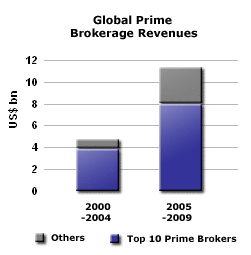The Burgeoning Business of Prime Brokerage
Abstract
Global prime broker revenues for the five years ending 2004 reached US$5 billion. Over 20052009, Celent anticipates that they will reach US$11.5 billion.
 In a new report, , Celent discusses key market trends in the prime brokerage industry and pays particular attention to technology developments. A case study shows how one prime brokerage firm is using technology to deliver immediate access to core infrastructure for fund managers. The report also outlines current and future challenges for prime brokers in the face of a hedge fund boom that will inevitably wane.
In a new report, , Celent discusses key market trends in the prime brokerage industry and pays particular attention to technology developments. A case study shows how one prime brokerage firm is using technology to deliver immediate access to core infrastructure for fund managers. The report also outlines current and future challenges for prime brokers in the face of a hedge fund boom that will inevitably wane.
The current leading prime brokers are Goldman Sachs, Morgan Stanley, and Bear Stearns; together, they represent 55 to 65 percent of the market. However, this is set to change with the explosive growth of the hedge fund industry. Celent predicts that global hedge fund assets will grow at an average annual rate of 16.5 percent over the next five years, reaching US$2.1 trillion by 2009. This growth will perpetuate demand for prime brokerage services at all points of the hedge fund life cycle.
Other changes in the industryincluding new technology, market structure changes, growth in a derivatives market that is increasingly complex, and bank consolidationswill modernize firms, enable cross-asset class servicing, and spur innovation in prime brokerage. For the first time in the history of the industry, capitalizing on changing dynamics is not restricted to the top few firms.
Prime brokers are aggressively adding services for hedge funds, but many of these can be duplicated by fund administrators, technology providers, and even outsourcing firms. Although the prime broker is closest to hedge funds from an investment and operational perspective, funds are reluctant to allow any one firm access to all their investment activity. As hedge funds grow, they bring more administrative and operational activities in-house, or centralize activities with a third party.
"Although prime brokers are currently enjoying revenue and growth opportunities, a word of caution is in order. This growth may be concealing a few flaws," says Denise Valentine, Celent analyst and author of the report. From a technology perspective, prime brokers are still coping with legacy back- and front-office systems. From a target market perspective, the boom of new hedge funds will slow with eventual fund failures. And it is inconceivable to imagine that brokers current profit margins can be maintained if expenses continue to rise, Valentine adds.
This 36-page report contains 10 figures and three tables. A table of contents is available online.
of Celent Communications' Institutional Securities & Investments and Wholesale Banking research services can download the report electronically by clicking on the icon to the left. Non-members should contact info@celent.com for more information.
|

